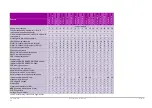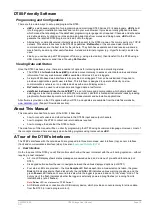
UM-0085-B09
DT80 Range User Manual
Page 24
RG
In a shared-terminal configuration, a sensor’s "return" or "negative" wire is usually connected to the channel's # terminal.
The remaining sensor wire (the "positive" or "signal") is connected to any of the channel’s other three terminals. The
common terminal need not be at ground potential – all voltage measurements (shared or unshared) are
differential
, i.e.
only the difference in voltage between the two terminals is reported.
For shared-terminal inputs, the channel number is given a suffix indicating the terminal to which the positive wire is
connected. For example, a shared-terminal voltage input applied to channel 1 between the + and # terminals is
recognized by the channel definition
1+V
.
Independent Analog Inputs
An independent input (also known as an "unshared" input) is one that connects to its own terminals and does not share
any of those terminals with any other inputs. For example, in
, sensor A is connected to channel 1’s + and –
terminals, and sensor B is connected to the other two terminals of the channel. In other words, each sensor’s terminals
are independent of the other’s — no terminal is used by both sensors.
Figure 5: Wiring one or two independent inputs to a single channel (voltage inputs used as example)
Note:
each analog input channel can support two independent voltage inputs. In the above example, the channel definition
1V
will read
sensor A while
1*V
will read sensor B. The channel definition syntax is fully described in
.
Sensor Excitation
Many sensors require
excitation
(electrical energy) so that they can provide an output signal. For example, to read the
temperature of a thermistor, excitation current is passed through the thermistor to generate a voltage drop that can be
measured.
The DT80 can provide:
•
Voltage source of approx. 4.5V via 1kΩ. Useful for powering some sensors however the supply is not regulated
and consequently liable to drift with temperature
•
2μA (approx.) current source. Excitation for high resistance measurement. Very stable over environmental
temperature range.
•
200μA (approx.) current source. Default excitation for resistance measurement. Very stable over environmental
temperature range.
•
2.5mA (approx.) current source. Default excitation for RTD and bridge measurement. Very stable over
environmental temperature range.
•
DT 80 Series 4 provide 16-bit resolution Voltage/Current digital-to-analog converter outputs at V/I DAC terminal.
The current outputs can be set within 0-24mA range and voltage is within 10mV-10V range. The DAC output
can also be used as an external voltage or current excitation for many sensors. It can also be externally routed
to EXT* terminal.
•
User supplied external excitation
EXT*
terminal. The user can provide an external excitation which is
appropriate to the sensor being used. See the Excitation category in the DT80 Channel Options
– P47)
.
More Information
For full details on how to connect sensors and make measurements using the DT80's analog inputs, see
.
















































